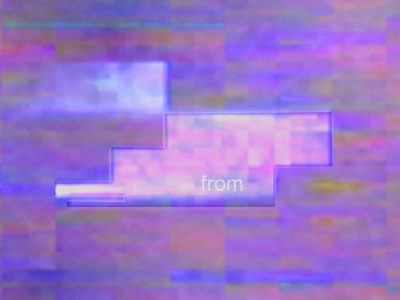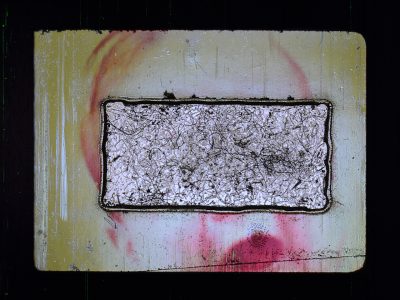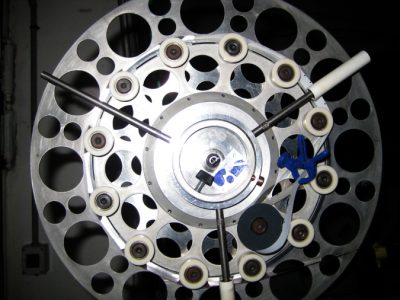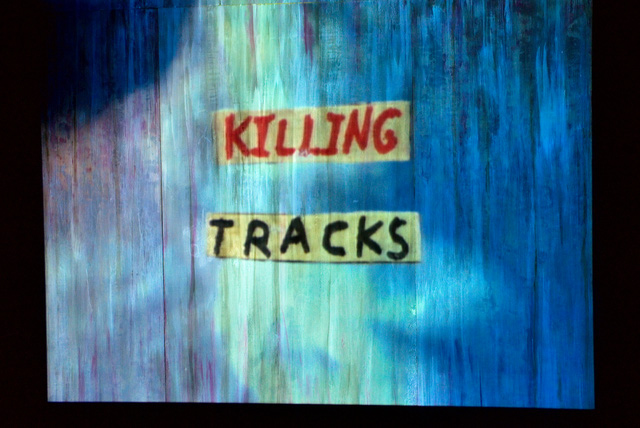
This Train Process UPDATED 6/2011; Started 5/2010
Process/Research ,
Documentation of my process making the video art for the play This Train. I did not know at the time of writing this blog that this project would turn into a four play series produced over 5 years. The work below acted as a foundation for the project at large: https://www.reevesmachine.com/american-trilogy-and-epilogue/
About This Train
July 15 – August 1, 2010
at Steppenwolf Merle Reskin Garage Theatre
written and performed by Tony Fitzpatrick
with musical performances by Kat Eggleston and John Rice
Directed by Ann Filmer
There are bums. There are tramps. There are hobos. And then there’s Tony. Some guys just can’t fit in. Fine artist, poet and storyteller Tony Fitzpatrick delves into the Hobo Alphabet.
Fitzpatrick’s THIS TRAIN was developed with Ann Filmer for 16th Street where all tickets were sold-out before it even opened in its premiere in Berwyn. Now THIS TRAIN returns with some additional material, an intermission.
Running time 100 minutes with one intermission.
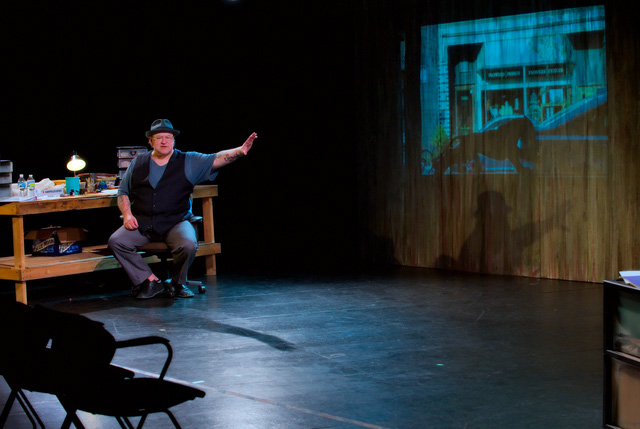
August, 2010 -Reviews and Press
Reviews
“…Video Artist Kristin Reeves has fused together the poetry and art of Mr. Fitzpatrick in beautifully cut sequences. The manner in which she has put together these videos perfectly coincides with the visual and verbal style of Mr. Fitzpatrick without copying it. These are among the most visually striking pieces of multimedia used in performance I have ever seen…” Jake
Radio
Nick Digilio’s interview with Ann and Tony about This Train on WGN radio. During the interview they talk about my contribution and Tony’s first impression of my work.
Pre-opening Press
Bad at Sports: Contemporary art Talk
Art Papers May/June 2010
This Train and the 16th Street theater are mentioned in the article: Tony Fitzpatrick: the Journey f a Latter-Day Flaneur
Thursday July 15, 2010 -Show opens
Approximately 50 video cues were produced.
Excerpts of This Train video/poem that runs through the play in 5 parts.
Wed July 7, 2010 -Video Presentation
Presented video in progress video to Tony and the rest of the performers today: 1st video poem opening; examples of art-scapes for Kat’s poem song sequences, and a time-lapse piece of Tony creating Pink Death, which will be chopped into the video poems. The work was met with overwhelming support from Tony and all involved. I had been in constant dialogue with Ann (staying at her home while away from FL) regarding the feel of the work, so she had been very supporting and encouraging during this initial phase. She has allowed me to dive into the work with full creative freedom, while providing me with the conceptual framework of her overarching vision. Tony was moved by the work as he felt it really captured the meaning behind his poem. Tony allowed me access to his life/art making practice / works/ words. I deconstructed and reconstructed the works based on his collage process, conceptual content, and his overarching inspiration. Luckily my work/practice shares common ground with Tony: collage, poetry, activism, portraiture, landscapes, documentary, LAYERS…
Broken Rosary poem song/animation process example:
Spent about 24 hours “cutting out” over 500 pieces of Tony’s Hobo Alphabet and Crazy Horse works to become the landscape of the Video Poems. By using some database management/naming consistency, I could search and create content by word search, copy, and dumping images into FCP at 1sec each.
Saturday June 29, 2010 – Production Update
After meeting with Tony Fitzpatrick and Ann Filmer upon my arrival on 6/16, there is the opportunity to expand on the multi-media component to act as something beyond a straight vessel for Tony’s 2D work. Now I am creating video that runs in conjunction with his poem This Train, approximately 10 min of poetic landscape, and experimental documentary: inspired by, created from, and describing Tony’s art practice. The poem is broken up in several parts throughout the play. I am also creating short video loops that will act as emotional and locational clues. The play as a whole is a series of stories performed in a somewhat improvised fashion so the video will help clarify the “location” they are experiencing at that time as the set does not change.
Over the last week and a half: finished shooting the base of the content, met with Steppenwolf crew regarding technical installation of the video, and secured a VERY nice projector from a man in Deerfield. Met with all involved in the production today for a run through and went over changes to the script from their last production. Now I am starting to edit…..
Thursday June 10, 2010 – Images and Influences
I don’t think that these images would be in the video design directly, but inspired and informed by them – will most likely be shooting in Chicago and finding documentary images for the play. Will be thinking of these when editing/shooting/composing

Providence Bob and Philadelphia Shorty riding the rails, 1894

O. Winston Link Rringer’s Living Room and View Negative 1955 Print 1976 – this image is great while thinking about the set design and video integration – window as screen in real life – LOVE this Image and this next one…

A “real” collage: O. Winston Link NW 1103, Hot Shot East Bound, Iaeger, West Virginia, August 2, 1956

Like the silhouetted image of the man in this tunnel. Imagine this image in relation to the Kennedy overpass where the homeless live. Also a great deep “window” within the frame; Juan Laurent The Zuera Bridge, ca 186

I like the abstraction and reduction of the tracks into lines -a layered framework – Willy Zielke Untitled 1933-35

The darkness and foggyness is very scary to me here -thinking about the play when the homeless are washed away with fire hose by the city – think the water and the train smoke could work as a similar image. The title on this photo made my stomach sink: Alfred Stieglitz The Hand of Man 1902
Images from Railroad Vision: Photography, Travel, and Perception by Anne M. Lyden 2003
William Henry Jackson Marshall Pass – Westside 1882-96
A.J. Russell Railroad Accident Caused by Rebels 1863-65
William Henry Jackson Marshall Pass 1882-96William Rittase Untitled 1920-30
Walker Evans Railroad Station, Edwards, Mississippi 1936
Walker Evans Railroad Tracks, New York 1929
Else Thalemann Lokomotivedetail 1926
Albert Renger-Patzsch Locomotive Detail 1925-28
Charles Sheeler Wheel, 1939
O. Winston Link NW 1103, Hot Shot East Bound, Iaeger, West Virginia, August 2, 1956
O. Winston Link Rringer’s Living Room and View Negative 1955 Print 1976
Alfred A Hart. View of the Forks of the American River, 3 miles above Alta. 1867-1869
Juan Laurent The Zuera Bridge, ca 1867
Alfred Stieglitz The Hand of Man 1902
Willy Zielke Untitled 1933-35
Mark Ruwedel Central Pacific #51 1995
Mark Ruwedel Canadian Pacific #3 200
Images from Chicago by Studs Terkel 1985
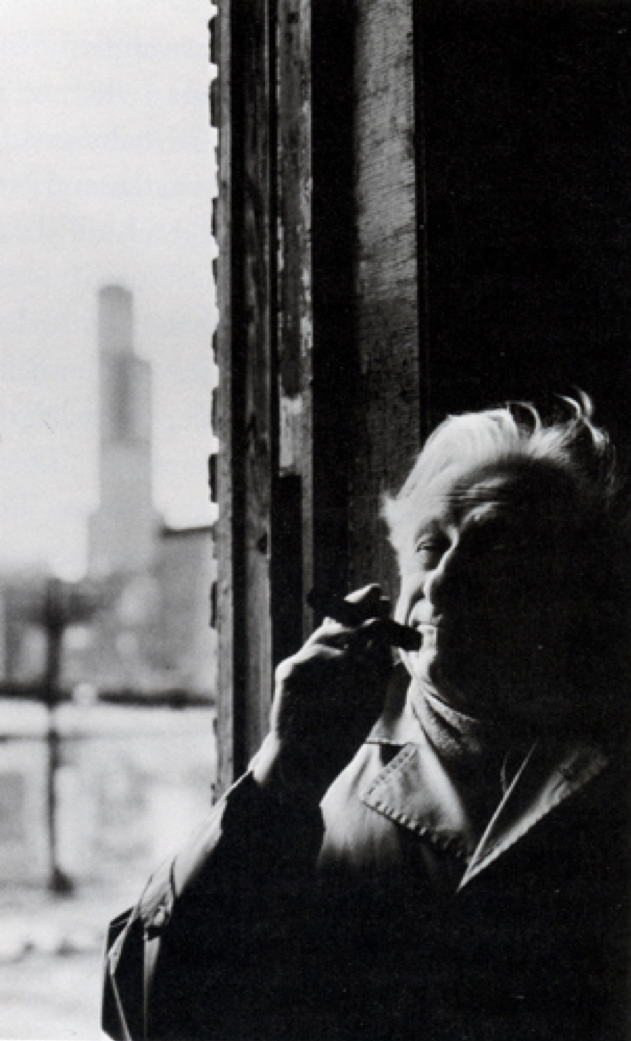
Studs Terkel Maxwell Street (Marc Pokempner 1985)

Abandon rails in North Lakeview (Richard Younker, 1976) Planning on looking for “abandon rails” both literal and metaphorical in Chicago for possible use in the video design.
Images from The Damndest Radical: The Life and World of Ben Reitman, Chicago’s Celebrated Social Reformer, hobo King, and Whorehouse Physician by Roger A Bruns 1987
Caption: “Nineteenth-century gentlemen of the road. Top: Providence Bob and Philadelphia Shorty riding the rails, 1894; Bottom: a hobo jungle, 1895”
Caption: “Hard days in the cities. Top: Chopping wood in exchange for breakfast at the Wayfarer’s Lodge, Boston, January 1895; bottom: washing up at the lodge.
Caption: Jungling in Downer’s Grove, Illinois
Caption: James Eads How, the “Millionaire Hobo” Fonder of the International Brotherhood Welfare Association, publisher of the Hobo News and mentor of Ben Reitman
Caption: Soapboxing in Chicago, 1920’s
Top: Cholly Wendorf, orator extraordinaire. Bottom: Washington Park 1928
From The New York Poets An Anthology Edited by Mark Ford
Why I am Not a Painter By Frank O’Hara

What I find remarkable in this work: in proclaiming why he is “not a painter” he reveals why poetry and painting are from the same heart and mind – also thinking about the lyrical musical nature of the verses. Very empowering to read (Frank O’Hara Poet Among Painters – images below) about his collaborations, and involvement with painters. It is also interesting to read about how his collaborations and cross discipline practice made some critics dismiss him as “not serious” because of his devotion to art in addition to poetry. I don’t understand how people between both disciplines dismiss image/text collaborations. It seems like the criteria for music is different, the band vs the solo artist – grass is greener or truth? If truth are image/text collaborations.
Images of Frank O’Hara’s collaborations with artists from Frank O’Hara: Poet Among Painters By Marjorie Perloff 1977
Perloff describes collaborations as not just between people, but between the media itself – any image made with more than one media regardless of the number of artists is a “collaborative” work. Under these terms I am a collaboration artist. I like this better than saying I’m a multi-media artist, but does this term sound too co-dependent.
Monday June 7, 2010 – see next post :
https://www.reevesmachine.com/the-screen-the-body-poetry-and-the-document-an-overview-my-practice-in-relation-to-the-16th-street-theater
The screen, the body, poetry, and the document: an overview my practice in relation to the 16th Street Theater
Not an exhaustive or perfected document yet. More…
Topics covered:
History with 16th Street
Karaoke for prosperity: Video Haiku
The Scarlet Ibis
Experimental Documentary and Fires in the Mirror
This Train
The Devil’s in the Details
Digital Prints and the screen
Next
Bio

Kristin Reeves is a multimedia artist interested in making work that blurs the lines between poetry, documentary, portraiture, and social critique. She is excited to be continuing her collaboration with director Ann Filmer on her third video design at Chicago’s 16th Street Theater for the production of This Train. Her solo and collaborative work inform each other and examine the virtual pictorial space as screen and window in relation to real physical space, objects, bodies, and image textuality.
Reeves is a Digital Media Art MFA candidate at The University of Florida where she is developing a body of work that builds upon her personal history as a pediatric research subject. Before moving to Florida, she lived in Chicago, producing solo and collaborative work including the video design for the plays The Scarlett Ibis and Patty Red Pants. She was also a member of the performance groups Milkbaby and the Impending Behavioral Orchestra. Her works can be seen at www.reevesmachine.com.
Thursday May 27, 2010 – Discussion with Ann
Phone call points:
(1) Tony is the boss and this is his world (2) Liked idea of showing images of Chicago then and now as well as places like the Kennedy overpass (Ann’s fav) (3) possible projection screen space as window in Tony’s studio – possibly train window or the moving landscape (my idea for Train poem and song moment)(4) possibly collage “Frame” used for this window space, reflecting Tony’s images – might happen in set design (5) play is a love letter to Studs (6) Animate/document production of a piece in process at Tony’s studio (7) need to represent the faceless – homeless (I’m thinking cut out and silhouette forms in Tony’s work as well as documented Chicago homeless – migrant workers(8) keeping in mind Tony’s desire to not manipulate his work – I will still create test which push the transition of the video into the pieces so they will rest as whole works but when moving..– might include fading in starting with drawing and then the found images; scaling from physical size to fill the projection window; parts of images moving like in a landscape across his window view such as his skull heads and cigar wrappers blowing in the wind- whizzing by… (9) I will move forward with research: Tony’s work and his influences; the discourse of art/theater/digital integration – who is doing what now; finding historic Chicago images; train aesthetic… (10) Ann posting images to FTP (11) Ann posting document of This Train’s 1st run to FTP (12) I will post videos/images/ideas to blog for Ann to see (13) I need to send her updated Bio for press ASAP
Timeline
Arriving in Chicago by June 16th (1)will set up at Ann’s. (2)Will do some shots of Damien Ave and other locations based on any historical images I find for rough tests. (3) ASAP – meet with Tony via Ann to show him tests and ask questions, gain his trust and find out how he would like to move forward (4) meet with set designer (5) go to the space (6) figure out projection equipment issues (7) figure out how large the image will be when projected so I can scale images to “real” size if need be (8) confirm a date for the videos to be roughly done for Tony to critique/change/tweak – thinking a min of 1 week before load in (9) arrange time for Tony to see progress – changes during that week – perhaps meet with him every day for an hour if need be or make myself available if he would like to sit with me and direct my changes on the spot…(10) LOAD in and tweak the videos for 3days/nights (11) enjoy the magic!
Wednesday May 26, 2010 – Writing
After watching Tony’s talk at D.D., my feeling is that This Train is the talk + work placed into a theatrical experience using the train and hobo alphabet as analogy (?To make a passive audience active – to not lose the memory of our history – to make the homeless human?)
What I feel is missing from the script dialogue or could be added upon/enhanced by the video design is his image process both physically and conceptually as well as talking to the change that the work goes through –transformation- between the gallery and the stage. Thinking of how I am handling or transforming these physical works into ephemeral form both in terms of projections (light) and performance (event). Also wonder how this art performance fits into contemporary multimedia performance theatrical/art works such as Joan Jonas’ Reading Dante II- I’m sure they have shown work in the same gallery venues/spaces but their versions of theater are very different – should be thought when thinking about the video function overall.
Tony rides the line between lots high and low art/people/topics with his practice and materials…Thinking of the in-between between train cars. This is still train space but it is unclaimed and dangerous. This is the space where hobos ride and Tony dreams. He stated that the logo alphabet is “Language of hunger and dispossession and hope” Perhaps adapted from cattle branding and adopted by tattoo artists
Here are what I felt were the key point that I took from the talk in relation to the video score in question: At one point in the talk, Tony said that the images “were out of Studs’ landscape” (I’ve been imagining landscapes/collage parts going by as various speeds and later while discuss the embedded poetry that he imagined them being the mindset of one or two people and finally that his process typically started with drawing first and found “trash” that became archival
Before hearing this I had stared to imagine the works in the context of the theatrical, This Train experience as the physical ticket presented in the form of the playbill. The audience sitting in their seats with this physical object which could be very close to the size of Tony’s colleges both in reality and in their printed form found in one of his published books and/or show catalogs. They sit in their seats passively waiting for the train to begin if you will reading the material either in a one or two person experience. I believe my mind’s eye was in tandem to what Tony was describing.
I wonder if this proposed “vision” could become part of a visual prologue or 1st train poem section: the various 2D pieces in rows (abstraction of overhead passengers/audience) transforming from small (real) to a large (ephemeral, theatrical, imaginative, enviro, landscape) projection size. This new size could still be suggesting the mindset of single or 2nd “passenger” as a window looking out into Studs landscape as the train goes by. The audience as passenger could see the singular pieces of “trash” go by in this frame space and become permanent. Wonder if there is any room for interaction between the projections and the performers…
While Tony complements/describes Studs as a good listener, collecting story via interviews and observation, I think of Tony’s collection of “trash” as the same thing. Listening becomes looking. Both are communicated in various story narration form…Tony always wants to place himself in the context of this (via image of his eye or his performance) not sure if Studs did this… Thin that both styles follow the same styles of the “documentary”. I could imagine how Studs might have excitedly described finding beauty in the stories of others in a similar way that Tony finds it in found paper objects and/or the people he meets when collecting the paper
To do list for more research:
Look at and think about Bruce Conner, Frank O’Hara, and the American Handmade and the film Emperor of the North – Tony influences – as well as read sections of Stud’s Hard Times.
Digital Theater and art:
From The New York Poets An Anthology Edited by Mark Ford
Why I am Not a Painter By Frank O’Hara
– a chapter within Digital Performance by Steve Dixon. – Talking about the 2D projection surface as a poetic space in conjunction with theater and performance art history.
Tuesday May 25, 2010 – Listening
Tony Fitzpatrick’s Gallery Talk at Dieu Donne regarding the Hobo Alphabet 2D collage work
In both the talk and in This Train script Tony talks about Kenneth Patchen’s Origin of Baseball poem
Selected Poems of Kenneth Patchen: Read by the Author
by Kenneth Patchen
The seminal text for the series per his talk: Studs Terkel’s Hard Times
The text is an oral history of the Great Depression – a series of various individual’s stories. Studs listened.
I listened and per Tony’s talk:
The hobo alphabet series is “..language of hunger, dispossession, and hope.”
The work is important because per Studs – we have a “foreshortening of our memory” – talking about our history in the US and how hobos and the hobo alphabet is a part
This work comes out of “Studs Landscape” – I wonder if we can suggest this in the video design via the view of the train window
The collages are produced with stuff that is thrown away – with his process he makes this “trash” an archival object – an experimental documentary –poetics
Besides collecting his process usually starts with drawing. He tried keeping these images simple but found himself drawing a “creature” now and then. Also he placed himself in the work by illustrating his eye in some of the pieces. It is important that he is in the work. His works (perhaps past and present?) have been described as a form of a diary, which makes since given the size of the works. How does this change once performed, and the images enlarged via projections.
His collage/poet influences mentioned here: Bruce Conner, Frank O’Hara, the American Handmade
Wednesday May 19, 2010 – Reading, Looking & thinking
READING: Photo-Textualities
Pg12: New studies are not asking/searching for the intrinsic identity of photo, but what photos DO. Alan Trachtenberg “The cultural ideological work it performs” -The cultural work that representations perform – human/mechanical/verbal/visual/popular. MY ?: What do the images DO in This Train.
Pg 14: Collaboration: Let us now praise famous men – the context spills into each other. Mary Ann Caws model of interference: ex 2 radio stations simultaneous and inseparable. Jefferson Hunter: Focus on each strength and find common ground.
MY Thoughts: With my collaborations with live performance, I want to move beyond an illustration mode or a caption/image model. Ideally I would like to always be a autonomous artist/contributor in the collaborative team; video/time based/digital/electrical artist. For This Train I am a designer and not the “artist”. Not about me or what I provide but what Tony’s images provide, what video in a live performance provides.
What can the video/Image do in terms of its autonomous quality in the live event/performance? (1) movement (animation): scale, rotations, fade, speed, TIME (2) environment: window, landscape, sky, ground, room, AT specific TIME or in relation to TIME movement, etc.… Changing, Temporary. (3) interactive with performers: shadows, manipulation of shadows real vs unreal, performer actor/music sound directs the change or image directs the performance; Interactive with the audience: text, live capture of audience into the work. (4) perspective – split screens, ability to house multiplicity, ability to suggest inside and outside at the same time or within the same segment/scene, scale, depth, color, value, All in the same place if the screen is static.. (5) Presence/crossing of the cinematic within the theatrical (6) Presence of “Media” into the theatrical – what is this and is its difference pronounced used – news – tv- web…. (7) projections are lights – ephemeral
Pg 15: Thomas Hines: “When we confront a composite work we experience most immediately the effects of the collaboration of the arts rather than the acts of collaboration of the ARTIST’s. Photo/Lit’s differences are exposed. Corey Creekmur: pics in novels mess up my “suspension of disbelief” because they give proof = belief. My response: Not sure I buy the idea that presenting an image within a narrative messes up “suspension of disbelief”. Instead I think it can change/enhance/give perspective (for better or worse) a readers idea of what is being presented. If the narrative and the visions it’s producing are powerful and the image is not, then the image could be discredited and the reader could continue with their (conflicting?) vision… perhaps conflict can be a good thing. Thinking about intersections between video and theater and with documentary/advertising/news/portraiture/poetry/event. Where are the “real” parts and what makes them such. Thinking about the blurred documents of fantastical creatures such as big foot. The blurring movement can make them more real. Their fantastical more enhanced like a Hitchcock shadow…
Thinking: This Train’s script structure as a reflection of the video structure. Script structure: (1) allegory (2) narrative (3) Tony’s process/bio (4) practical structural elements, i.e. transitions. Think by reviling the priority in the script we can reflect that priority in the video design. How can the video represent the allegory, the narrative, Tony, the play’s structure/scene changes etc..
Allegory in the work: the thrown away disposable people in the world – specifically in USA – . Locally – The transformation of Damen Ave from poor (and male?) to chic (and female? per Tony’s Feminine empowerment). Tony’s use of “disposable” trash as art medium in his 2D work and in his subject matter of the Hobo. By making both he moves these subjects and parts up from the gutter and into the public’s eye – respect. Can/should this be suggested/enhanced with the video design? Can language of the homeless hobo be heard with the enjoyment of a bird’s song?
LOOKING: Joan Jonas – Reading Dante; Reading Dante II
Description per artdaily.org, Stefan Bruggemann “The plethora of elements employed by Jonas, which initially may seem disparate, collectively form a complex, choreographed, and imaginative vision in the artist’s personal aesthetic language. “
A space collage with performance/video/objects and words. Love the interaction with the performer/figures in the projection light… Per Artforum: an “epic collage” the work successes in not offering up evidence for the “real” text it is inspired by, but by being an individual thing in relation to or as a new reading of…Her work pulls it up into now…
Thursday May 13, 2010 – Beginning with a large net
What I want to accomplish: to make projections – (most importantly Tony’s images) appear intentionally integrated and to act in tandem, alive (performing), with the performance as a whole. Oh course no gimmicks or clichés..
Metaphor and allegory within the art projection: Believe it is my job to make them inseparable visually and conceptually. Do not think they should be a static background “wallpaper” throughout. Within the script is Tony’s process/history/motivations as well as the narrative/alphabet. Can we extend -subtly/intentionally/- this to the presentation of the work? quick ex. if the work fades what appears first? Is it the whole thing or could/should we first see poetry then image/symbol – is it always the same? How is the work framed, etc……
Thinking in parallel terms of the Art and the Train – I need to understand: how the art “functions” in the play as much as I need to understand written words in the script. Per Last Train script: ..”no art no art dealer”…. I think – no art no This train. Is this correct? Can the play exist without it? I’d think not (or if not I need to make it appear otherwise). If correct then why and how does this happen. How does the 2D work position itself to the audience/performance/Tony as actor/space vs how does Tony come to create the work? How do I enhance/capture/communicate this relationship while at the same time attending to the structure of the script/narrative.
ART -Tony questions: how are the images developed? How does he view his visual vocabulary? Is it created or is he reading/seeing/collecting/responding to what is there and arranging it like notes on a scale or written poetry? When/where is his hand – does he draw the line/skulls/notes? Is this important and why? How/where/what is HIS language in relation to the Hobo Alphabet – hobo symbol vs his bird for example. Is he contributing to the alphabet or reflecting it? What does it mean to reveal the Hobo Alphabet? Is it to make visible the invisible and legitimizing a universal language (as it is similar across the world)? Is Tony the Hobo King and if so is it to pull up his “subjects” into a legitimate space? What is the relationship in size in his images, small corner squares vs frame.
Train – Visual impulses/questions: What is the perspective of the train and does this change at various times in the play? (1) Observer of the train – possibly silhouettes of train cars going by with the in-between reveling images. Or are the images the various train cars? Are the collage components the passengers? (2) passenger on the train perspective – Paying passenger view out the window – what do you see and how do you see it framed -how do you feel, ok not in control, passive?? -Hobo passenger – view from a box car or on top of a train – what does this vantage point share with the bird – does this get paralleled with the “legitimate” passenger (3) the conductor or the train itself – what or how does it see – open landscape speeding forward or are you in a tunnel vision mode – can you see behind you or who you are carrying forward with you – do you have control/compassion/responsibility – the tracks have been given to you – what are your choices –fast/slow/stop/…
Key script points/ideas/questions/jumping out to me
Legitimate vs. illegitimate / rich vs. poor / face vs. faceless/passive vs. action
What are their vantage points in relation to the train and is this important to how the images/projections are framed/entered into/understood?
Impulses/ideas after initial reading of scrip and Tony’s blog:
Opportunities beyond showing art in static slide show form: (1) during projection/music train poem scenes – example opening train #1 – “collage” of the collage works (?), appearing in a train prospective (see train visual below) or are there visual/image transitions later in the play that could be fist suggested here, are there details that could be “highlighted” like the alphabet symbols, music notes, skulls, cut of figure, text, “cut out” … are they moving like a speeding train or coming to a stop -vantage point…; (2) transitions from one piece/scene to another – example Town without Mercy /Sally sings then to either black or next projection – that in-between could be an area of brief visual/conceptual exploration – poss. 2 to 5 sec animation; (3) to heightened environmental representation at key emotional/plot moments – ex. Fight on the train -is the landscape (whatever that may be real/abstract/art) racing by to suggest the moving train -ex Tony vs the Fire hose and hungry ghost – “becoming invisible”/ water “wipe out” – the FORCE of the water, faceless, cut outs…
Conceptual impulses/ideas at this time: (1) to suggest the collage/art/tony process; (2) representation of environmental “train” aesthetic; (3) the invisible homeless and poor., (4) don’t give up vs. get out fast, (5) direction/speed in various terms –country/community/individual/animal/human/machine
Installation questions: What is this set design? Where do the projections live and how large are they? What is the projection surface? How does this function for performer and audience? How are the projections framed is this part of the design – obvious or invisible? Could this be reflective of how Tony frames his works? How does this inform the projections? Is this a window, in-between reality, accepted background element and does this ever change or should it be a fixed template? Are there any moments when the images come to the foreground or are they always in the background as environment? WHY…
To do(understand) list: to develop key visual vocabulary for the play – and know how and when to introduce and repeat. – To know how Tony’s work can be handled – what are the rules… what is considered “manipulation” – how far to push, pull, is break in the mix-split screen/view?

